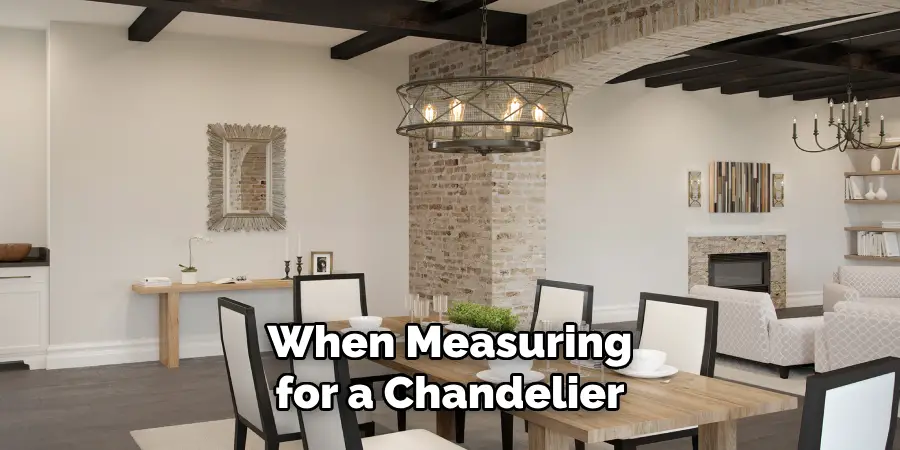Selecting the perfect chandelier to complement your space involves more than just aesthetic considerations – it requires precise measurements to ensure a harmonious and well-balanced design.

Knowing how to measure for a chandelier is crucial to achieve the right scale and proportion in any room. This article serves as a comprehensive guide, offering step-by-step instructions on the measurement process.
From determining the appropriate chandelier diameter and height to considering the room’s size and layout, this guide empowers homeowners and decorators alike to make informed decisions.
Whether you’re illuminating a dining room, foyer, or any other space, understanding the intricacies of chandelier measurement ensures that your lighting fixture becomes a seamlessly integrated and visually pleasing focal point in your home.
Importance of Proper Chandelier Sizing
Proper sizing of a chandelier is paramount as it influences both the aesthetic appeal and functional capability of the light fixture. A chandelier that is too large for a space can overwhelm the area, causing a disproportionate feel to the room’s layout.
Conversely, a chandelier that is too small will fail to make a desired impact or provide adequate illumination, leaving the space feeling underwhelming. Sizing considerations play a critical role in achieving the right balance between form and function, ensuring the chandelier complements the size of the table below it, the overall room dimensions, and the ceiling height, all while enhancing the room’s ambiance and visual comfort levels.
The Measurement Process

Before selecting your chandelier, you’ll want to take into account three primary measurements: room dimensions, ceiling height, and the relationship between the fixture and any furniture it will be complementing, such as a dining table. It is helpful to use the following steps as a guide:
- Calculating Diameter: For the room’s diameter, add the length and width of the room in feet, and then convert that number to inches. This will be an ideal diameter for your chandelier. For example, a room that is 12 by 14 feet would best fit a chandelier that is approximately 26 inches in diameter.
- Determining Chain Length: For rooms with 8-foot ceilings, aim for a chandelier that hangs about 30 to 34 inches above the tabletop. For each additional foot of ceiling height, add 3 inches to the hanging height.
- Sizing for Height: Measure the height of the room from the floor to the ceiling, and divide that number by four to get an ideal height for the chandelier itself.
- Consider the Table: Make sure the chandelier is not larger than the width of the table over which it will hang. A good rule of thumb is for the chandelier to be 12 inches narrower than the table’s width.
By following these steps, you’ll ensure that the chandelier you select is proportional to your space, enhancing your room’s overall aesthetic and functionality.
Significance of Room Size and Style
Understanding the significance of room size and style when choosing a chandelier is vital for a cohesive interior design. A large, ornate chandelier could overwhelm a small room or conflict with minimalist decor, while a small, simplistic fixture could be lost in a spacious, opulently styled room.
Additionally, the room’s style should influence the chandelier’s design; a sleek, contemporary chandelier might suit a modern dining area, whereas a classic crystal design might be more appropriate for a traditional setting. When both size and style are thoughtfully considered, a chandelier can act not only as a source of light but also as a piece of art that enhances the character of the room.
Identifying the Focal Point in the Room

When measuring for a chandelier, it’s important to identify the focal point of the room, as this is where the chandelier will likely hang. The focal point is typically the most visually dominant feature in the room and can be anything from a large window or a fireplace to a piece of art or the main table in a dining room.
Observing the room’s architecture, furniture layout, and intended use helps to determine this central feature. Once the focal point is established, the chandelier can be positioned to complement and enhance this central aspect of the room, ensuring it attracts the right amount of attention and contributes positively to the room’s ambiance.
Account for Ceiling Height and Potential Obstructions
When installing a chandelier, evaluating the ceiling height is a crucial step that affects both the hanging length and the style of the fixture. Rooms with high ceilings may accommodate elaborate chandeliers with longer chains or multiple tiers, while low ceilings might necessitate a flush or semi-flush mount to maintain head clearance and room balance.
It’s imperative to consider potential obstructions such as ceiling beams, fans, or air vents that could interfere with the placement or operation of the chandelier. In spaces with ceiling obstructions, positioning the chandelier so that it hangs in harmony with these elements without compromising functionality or design is essential.
For rooms with exceptionally high or sloped ceilings, professional installation might be recommended to ensure that the chandelier is securely and strategically placed.
Ensuring Proper Clearance from Walls and Furniture

When situating your chandelier, it’s vital to allow for proper clearance between the fixture and surrounding walls or furniture. This consideration helps to prevent the space from feeling cramped and ensures the chandelier’s light is well-distributed. A general guideline is to maintain at least 48 inches of space from any wall or large piece of furniture.
This clearance helps to avoid any visual overcrowding and allows for natural movement within the room, ensuring the chandelier remains a functional adornment rather than an obstruction. Furthermore, it accentuates the chandelier’s presence as a standalone feature while still integrating smoothly within the room’s overall layout.
Measuring the Room Dimensions
Before you begin your search for the perfect chandelier, accurately measuring the room dimensions is an essential first step. This includes recording the length and width of the room at the widest points, as well as the ceiling height. These measurements will inform you of the scale of the chandelier that the room can comfortably accommodate without overpowering the space. To ensure precision:
- Length and Width: Use a tape measure to find the distance from one wall to the opposite wall. Measure in feet and round off to the nearest whole number for both length and width.
- Ceiling Height: For the height, measure from the floor directly up to the ceiling. This dimension is critical when determining how high the chandelier will hang.
- Room Shape: Take note of any unique features of the room shape, such as alcoves or recesses, as these may affect the chandelier’s placement and size.
Keep these dimensions handy as you proceed with selecting a chandelier to ensure a harmonious balance between the fixture and the room it will illuminate.
10 Methods How to Measure for a Chandelier
1. Determine Room Size:
Begin by assessing the size of the room where you intend to install the chandelier. Measure the length and width of the room in feet and add those figures together. The sum in inches is a good starting point for the diameter of your chandelier.

For example, if your room is 15 feet by 12 feet, the chandelier should be approximately 27 inches in diameter. To determine the chandelier’s height, measure the room’s ceiling height in feet and multiply that number by 2.5 to 3 inches. This will give you a general range for the chandelier’s height.
2. Establish Chandelier Diameter:
Use the room size measurement to determine the appropriate chandelier diameter. For rooms up to 10 feet by 10 feet, a chandelier around 17 to 20 inches in diameter may suffice.
Larger rooms may require chandeliers ranging from 24 to 36 inches or more, depending on the space’s dimensions. Consider the size of your furniture and the ceiling height as well. A chandelier that is too small may look out of proportion, while one that is too large can overwhelm the space.
Based on the room size and dimensions, you can also determine the number of lights needed for your chandelier. For example, a standard 20-inch diameter chandelier with eight-foot ceilings would typically have five or six lights. However, a larger 36-inch diameter chandelier with the same height ceiling may have eight to ten lights.
3. Consider Room Type and Function:
The function of the room plays a significant role in chandelier size. For a dining room, consider using the dining table width as a basis for chandelier diameter.
In other spaces, such as foyers or living rooms, factor in the room’s function, ceiling height, and furniture placement when determining chandelier size. However, the current trend is to go for larger fixtures that make a statement and add visual interest to the room.

In addition to function, consider the room type when selecting a chandelier. A traditional grand chandelier may not be suitable for a contemporary minimalist space.
Similarly, a modern geometric-shaped chandelier may look out of place in a classic Victorian-style room. Take into account the overall design and style of the room to ensure that the chandelier complements and enhances the space.
4. Ceiling Height Matters:
The height of your ceiling influences both the size and the hanging height of the chandelier. For standard 8-foot ceilings, a chandelier should typically hang 30 to 34 inches above the tabletop or furniture.
Higher ceilings may require adjustments; add 3 inches for every additional foot of ceiling height. For example, a 10-foot ceiling would need the chandelier to hang at least 36 inches above the tabletop or furniture.
When considering ceiling height for your chandelier, it’s also important to consider the scale of the room. A large chandelier in a small room with low ceilings can feel overwhelming and out of place. Similarly, a small chandelier in a large room with high ceilings can look lost and insignificant.
5. Optimal Hanging Height:
Achieving the correct hanging height is essential for proper illumination and visual appeal. In dining rooms, the bottom of the chandelier should be around 30 to 36 inches above the dining table.
In spaces with higher ceilings, consider a slightly greater distance for an elegant appearance. In living rooms and bedrooms, the recommended hanging height is usually around 60 to 66 inches from the floor. However, this can vary depending on the size of the room and the ceiling height.

When it comes to pendant lights or other hanging fixtures, there are a few factors to consider when determining the optimal hanging height. First, think about how you will be using the space and what activities will take place under the fixture. For example, in a kitchen with an island, the hanging height should be lower to provide ample task lighting for cooking and food preparation.
6. Account for Chandelier Shape:
The shape of the chandelier is another factor in the measurement process. Consider the chandelier’s proportions and how they align with the room’s layout.
For example, a linear or rectangular chandelier may be more suitable for elongated dining tables or spaces with specific design requirements. On the other hand, a round or oval chandelier may complement circular or square dining tables and add a softer touch to the room.
When taking measurements for a chandelier’s shape, it is important to consider the width and height of the fixture. The width refers to the horizontal distance from one end of the chandelier to the other, while the height refers to the vertical distance from the ceiling to the bottom of the fixture. These measurements will help determine the appropriate size of the chandelier for your space.
7. Determine Chandelier Height:
Chandelier height is critical for achieving balanced aesthetics. Measure the chandelier’s height, excluding the chain or rod, to ensure it suits the room’s proportions. For rooms with low ceilings, opt for a more compact chandelier with a shorter overall height.
A higher ceiling allows for a larger chandelier or one with a longer chain or rod to create an elegant visual effect. However, be careful not to hang the chandelier too high or it will lose its impact and appear disconnected from the rest of the room.
8. Size Guide for Dining Tables:
When selecting a chandelier for a dining area, adhere to a size guide based on the table dimensions. For a rectangular table, the chandelier should be approximately one-third the table’s width.
In a square room, aim for a chandelier diameter that is approximately half the table’s width. For round tables, the chandelier diameter should be equal to the table’s width. While these are general guidelines, consider the overall size and height of both the room and the table when making your selection.
When it comes to dining tables, there are different sizes available depending on your needs. The most common shapes for dining tables are rectangular, square, and round. Rectangular tables tend to be longer and narrower, accommodating more people. Square tables have equal sides and are ideal for smaller dining areas. Round tables have a circular shape, making them great for intimate gatherings.
9. Multiple Chandeliers in Large Spaces:
In larger rooms or open-concept spaces, consider using multiple chandeliers instead of one large fixture. This approach ensures even illumination and creates a cohesive design. Follow the same measurement principles for each chandelier based on the room’s size and layout. You can also mix and match different styles or sizes to add visual interest.

For example, if the room is rectangular in shape, hang pair of chandeliers on either side of the longest wall. If the ceiling height allows, you can also add a third chandelier in the middle to create a symmetrical look. When choosing multiple chandeliers, make sure they complement each other in terms of style, finish and size. You can also opt for chandeliers with adjustable arms or swivel joints to direct light where it’s needed most.
10. Visualizing the Chandelier:
Before finalizing your chandelier selection, use visual aids such as cardboard cutouts or painter’s tape to mock up the size and placement. This allows you to assess how the chandelier interacts with the room and its surroundings, helping you make informed decisions.
Though the size and placement of a chandelier may follow certain guidelines, it ultimately comes down to personal preference and what best suits your space.
Conclusion
In conclusion, measuring for a chandelier involves a thoughtful consideration of both practical and aesthetic factors to ensure the perfect fit for your space. By accurately determining room dimensions, calculating appropriate chandelier diameter and height, and considering style preferences, homeowners can create a harmonious and visually pleasing focal point in any room.
The process of measuring for a chandelier not only ensures proper proportions and functionality but also enhances the overall ambiance and character of the space. Moreover, taking into account lighting needs, room usage, and traffic flow contributes to a well-balanced and inviting atmosphere.
Hopefully, this article gave you some helpful tips about how to measure for a chandelier successfully, so now that you have the proper knowledge on how to get the job done, why not give it a try today?

